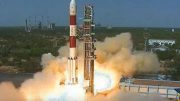An attempt by the Indian Space Research Organisation (ISRO) to launch an Indian navigation satellite IRNSS-1H to “augment’’ navigation services in the subcontinent failed Thursday after a heat shield, protecting the satellite on board the PSLV-C39 rocket, did not detach. The IRNSS-1H launched from the Satish Dhawan Space Centre — the Sriharikota High Altitude Range (SHAR) — in Andhra Pradesh at 7 pm Thursday on board ISRO workhorse PSLV but the rocket lost velocity after the heat shield failed to separate at the requisite height.
The PSLV-C39 managed to deliver the IRNSS-1H satellite to its designated orbit in space but with the heat shield still stuck on the satellite, the quality of signals received sub-optimal and ISRO declared the mission unsuccessful shortly after the final stage of the launch.
ISRO chairman A S Kiran Kumar
“During the operation, the heat shield has not separated. Further analysis will carried out subsequently,’’ the range operation director for the IRNSS-1H mission said at SHAR after completion of the entire launch sequence. ISRO chairman A S Kiran Kumar, who was at the launch site, said “the mission is unsuccessful’’.
Kiran Kumar said though all stages of the launch were carried out, the mission failed because the heat shield did not separate from the rocket. “The satellite is still inside the fourth stage of the rocket because the heat shield did not separate. We have to check the heat shield separation command and analyse what happened subsequently,’’ he said.
In a normal PSLV launch, the heat shield on the rocket is supposed to peel off and fall away when a rocket leaves earth’s atmosphere and reaches an altitude of around 120 km. In the case of the PSLV-C39 launch, this did not happen and the heat shield stayed attached through to the final rocket stage.
The failure of the IRNSS-1H launch is the first on board the PSLV since 1994 when the rocket became operational. Prior to Thursday’s failure, the rocket had been successful in 39 consecutive missions, delivering 48 Indian satellites and 209 foreign satellites to space.
The heat shield is an encasing which protects the satellite housed in the rocket from heat and acoustic pressures that it would experience during the lift-off phase in the earth’s atmosphere. Once outside the atmosphere, the pressures reduced, allowing removal of the shield.
Initial analyses of the launch, sources said, have revealed that though the command for separation of the heat shield executed, the mechanical task of actual separation did not take place.
Former ISRO satellite centre director S K Shivakumar said:
“The rocket worked till the end but it did not have the requisite velocity. It should have had a velocity of 9.5 km/sec in space but it only had a velocity of 8.5 km/sec. The signals received from the satellite after the launch is 30 decibels below optimum. If the heat shield had separated, we would have got good satellite signals.’’
The IRNSS-1H intended to replace the IRNSS-1A satellite which launched in July 2013 — one in a seven-satellite constellation — but developed problems in delivering navigation services on account of the failure of three Rubidium Atomic Frequency Standard atomic clocks on the satellite.
The atomic clocks are a key component of satellite navigation systems. The ISRO satellites all equipped with three rubidium atomic clocks each — with one clock being the primary timekeeper and two clocks acting as back-up on each satellite. Accurate timekeeping lies at the heart of navigation systems since the determination of a person’s position on earth is subject to the accurate calculation of delays in signal transmission from a satellite to earth.
Defence purposes:
One of the reasons ISRO began development of the indigenous Indian satellite navigation system is its use for defence purposes. The system is similar to the Global Positioning System of the US, the Russian GLONASS, the European Galileo and the Chinese BeiDou.
ISRO started work on the Rs 1420-crore IRNSS programme in 1999 after the Kargil war where Indian armed forces could not use American GPS in the conflict zone to locate its soldiers.
ISRO has one more satellite in its kitty for the IRNSS series out of a total of nine. A new satellite could launched over the next few months to make up for the loss the of the IRNSS 1-H. According to Kiran Kumar, efficient navigation services can even be provided by the six IRNSS satellites that are currently in space.




Be the first to comment on "ISRO IRNSS-1H launch fails after heat shield does not detach"